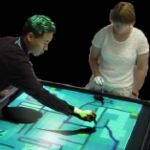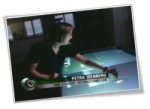Collaborative Coupling over Tabletop Displays
Researchers
Summary
Designing collaborative interfaces for tabletops remains difficult because we do not fully understand how groups coordinate their actions when working collaboratively over tables. We present two observational studies of pairs completing independent and shared tasks that investigate collaborative coupling, or the manner in which collaborators are involved and occupied with each otherís work. Our results indicate that individuals frequently and fluidly engage and disengage with group activity through several distinct, recognizable states with unique characteristics. We describe these states and explore the consequences of these states for tabletop interface design.
Coupling Styles
These are the types of coupling styles we identified. Note that round parenthesis around the abbreviation mean working together (close coupling) and square brackets mean working apart (loose coupling):
Close Coupling:
(SPSA): (Same problem same area): Collaborators are actively working together to evaluate, trace, or draw a route (e.g. one person points at landmarks while the other connects them with a pen). Often, this is accompanied by conversation.
(VE): (View Engaged: One working, another viewing in an engaged manner): The pair is working together, but only one is actively manipulating the display. For instance, one may be showing a route to the other, or one may just be watching the otherís actions very carefully. In the latter case, the individual is watching closely enough to suggest corrections. Conversation often accompanies this style.
(SPDA): (Same problem, different area): Collaborators are working simultaneously on the same sub-problem, but are focused on different parts of the table. For instance, participants may be evaluating alternate solutions of the same sub-problem. This style is not accompanied by conversation. Instead, conversation and gestures often transition groups to more tightly coupled work.
[V]: (View: One working, another viewing): One collaborator is working on the task, and the other is watching, but is not sufficiently involved to help or offer suggestions. The person watching only reacts to highlevel activities, such as when the active person stops working or needs resources (e.g. a widget).
Loose Coupling:
[D]: (Disengaged: One working, another disengaged): One collaborator is completely disengaged from the task, not paying any attention to the task or partner.
[DP]: (Different problems): Collaborators are working completely independently on separate sub-problems at the same time. Each personís interactions with the workspace are not related to the other in any way. In this style, participants often peeked at one another to maintain an awareness of the otherís activities.
Extensions
If you are interested in the topic, I used and extended this set of styles in an analysis of a collaborative visual analytics task. See the VAST 2010 paper for more detail (link below).
Examples

The paper is more theoretical in nature - there are very few images. This one shows two people completing the route finding task.
